Hurricane eMatrix
List of Activity Sheets » Operation-specific sheets
Hazardous Waste Operations and Emergency Response (HAZWOPER) Activities
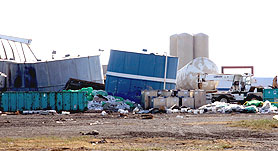
This picture shows actual disaster site work conditions and may not illustrate proper safety and health procedures.
Activity Description
- This activity sheet is for response and recovery workers who will conduct emergency and post-emergency response operations involving or potentially involving releases of hazardous substances. It also covers work involving hazardous substances at recognized, uncontrolled hazardous waste sites, Resource Conservation and Recovery Act (RCRA) sites, and Environmental Protection Agency (EPA)-regulated hazardous waste treatment, storage, or disposal facilities (TSDs). Specifically, this sheet is primarily intended for designated hazardous materials response teams and trained hazardous waste site workers, and their supervisors, when these individuals are involved in the operations defined in the scope of OSHA's Hazardous Waste Operations and Emergency Response (HAZWOPER) standard (29 CFR 1910.120 and 29 CFR 1926.65).
- For some operations or situations (e.g., entry into confined spaces, heavy equipment use) other activity sheets also apply; see related activity sheets below.
- For the purposes of this activity sheet, as stated in the HAZWOPER standard, a hazardous substance means a substance listed by EPA under CERCLA or by the U.S. Department of Transportation (DOT) as a hazardous material, a hazardous waste as defined by EPA or DOT, or a substance to which exposure may result in adverse effects on the health or safety of workers.
- As a result of hurricanes Katrina and Rita (2005), containers of hazardous substances were displaced over a wide area and must now be collected and treated as hazardous waste at designated facilities. Additionally, the storms caused hazardous substances in some locations to be accidentally released. Furthermore, pre-existing hazardous waste sites, RCRA corrective action sites, and RCRA TSDs, were also affected by the storm and may require special attention as a result of the disaster.
- The following are the specific types of sites at which this activity sheet applies: a) emergency response operations to stop the release of hazardous substances; b) post-emergency response operations to remove hazardous substances, health hazards, and materials contaminated with them; and c) sites where HAZWOPER already applied to site clean-up, treatment, storage, or disposal operations.
- While the requirements of OSHA's HAZWOPER standard apply to the incidents and sites described above, is important to note that there are many other hurricane-related recovery activities that will not be covered by this standard (e.g., sand and sludge removal; vegetative debris collection; building assessment; mold remediation; roof inspection, tarping, and repair).
- Where the HAZWOPER standard applies, the response, cleanup, and recovery activity should only be performed by designated workers who are trained and equipped according to the requirements of the standard. For more information, see the sections on Additional Medical Needs and Additional Training Needs at the end of this activity sheet.
- Response and recovery workers conducting this operation may be employed by Federal, State, local, and private employers. Review How to Use This Matrix in the introduction for a discussion of how this information may apply to different workers.
About the Activity Sheet
This activity sheet does not provide an in-depth analysis of OSHA standards and regulations and cannot address all hazards. It does not increase or diminish any OSHA requirement or employer obligation under those requirements. It is intended as a guide and quick reference for employers and response and recovery workers. The Matrix captures major activities involved in hurricane response and recovery, highlights many of the hazards associated with them, and recommends beneficial work practices, personal protective equipment (PPE), and other exposure control methods. Employers must evaluate the specific hazards associated with the job/operation at the site where the work is being performed.
Employers are responsible for providing a safe and healthful workplace for their workers. OSHA's role is to assure the safety and health of America's workers by setting and enforcing standards; providing training, outreach, and education; establishing partnerships; and encouraging continual improvement in workplace safety and health.
The Hazard Exposure and Risk Assessment Matrix for Hurricane Response and Recovery Work provides a general overview of particular topics related to current OSHA standards. It does not alter or determine compliance responsibilities in OSHA standards or the Occupational Safety and Health Act of 1970, or the equivalent State Plan standards and requirements. Because interpretations and enforcement policy may change over time, you should consult current OSHA/State Plan administrative interpretations and decisions by the Occupational Safety and Health Review Commission and the courts for additional guidance on OSHA compliance requirements. Employers should modify their procedures as appropriate when additional, relevant information becomes available.
General Recommendations
Key Engineering Controls and Work Practices. See general recommendations document.
Personal Protective Equipment. The general PPE is recommended for all response/recovery tasks/operations; only the additional PPE that may be needed for a specific hazard is noted below.
General PPE includes:
- Hard hat for overhead impact or electrical hazards
- Eye protection with side shields
- Gloves chosen for job hazards expected (e.g., heavy-duty leather work gloves for handling debris with sharp edges and/or chemical protective gloves appropriate for chemicals potentially contacted)
- ANSI-approved protective footwear
- Respiratory protection as necessary—N, R, or P95, filtering facepieces may be used for nuisance dusts (e.g., dried mud, dirt and silt) and mold (except mold remediation). Filters with a charcoal layer may be used for odors.
Recommendations Specific to Hazards Associated with Hazardous Waste Operations and Emergency Response (HAZWOPER) Activities
Key Engineering Controls and Work Practices
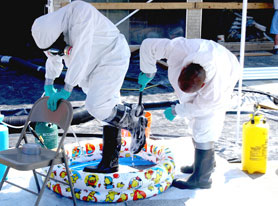
- For emergency response operations - follow the existing Emergency Response Plan. This plan must address the following:
- Personnel roles, lines of authority, training, and communication
- Site security and control
- Safe distances and places of refuge
- Evacuation routes and procedures
- Decontamination
- Emergency medical treatment and first aid; medical surveillance/consultation for workers that show any signs or symptoms of exposure as a result of the emergency
- Emergency alerting and response procedures
-
PPE and emergency equipment
- Conduct air monitoring to determine the extent of contamination and concentration levels of airborne contaminants
- Minimize time in areas where exposure could be strongest
- Decontaminate workers; train workers on decontamination procedures before they enter a contaminated area
- Decontaminate contaminated clothing and equipment; discard clothing and equipment that cannot be reused
- Ensure that all HAZWOPER operations at the site are performed by trained workers who are properly equipped for the roles they are assigned. Training is determined based on the worker's job, expected hazards, and stage of clean-up
- Employers who will evacuate workers from the danger area and will not permit workers to assist in handling the emergency do not need to follow the recommendations above but must establish and implement an Emergency Action Plan
- If clean-up operations are required after the release has been controlled, then these must be conducted following an established safety and health program designed for hazardous waste site clean-up. This program must include:
- The organizational structure, including (at a minimum) a general supervisor and safety and health supervisor
- A safety and health training program
- A medical surveillance program
- A personal protective equipment program
- The employer's standard operating procedures for safety and health
-
An interface between the general program and site specific activities
- Develop, and have available at the site, a site-specific safety and health plan. This plan must:
- Analyze safety and health risks for each task and identified hazards
- Prescribe worker training assignments, engineering controls, and PPE for each site task and operation
- Describe methods to be used to assess exposure to hazardous substance at the site (e.g., air monitoring plans, environmental sampling methods)
- Establish site control measures and decontamination procedures
- Establish a site-specific emergency response plan and a spill containment program
- Define confined space entry procedures
- Establish pre-entry briefings
- Describe how plan effectiveness will be evaluated
Additional Personal Protective Equipment
- Dermal protection including hooded chemical protective suit, inner/outer gloves, and boot covers suitable for the chemical and exposure concentration anticipated
- Total-encapsulating, chemical protective suits may be required for response to measured or anticipated high concentrations of a hazardous substance that requires the highest level of skin, eye, and respiratory protection based on work operations that involve a high potential for splash, immersion, or exposure to vapors, gases, or particulates that are harmful to the skin or are capable of being absorbed through the skin
- Other dermal protection may include, coveralls for particulate protection, and chemical protective aprons, goggles with indirect venting, and face shields for splash protection
- Respiratory protection that is suitable for the chemical and exposure concentration anticipated
- A positive pressure self-contained breathing apparatus must be used for an inhalation or potential inhalation hazard until air monitoring allows the individual in charge to reduce the level of respiratory protection and an air-purifying respirator is available that can remove the contaminants
Key Engineering Controls and Work Practices
- Inspect tanks, drums, and other containers for integrity before moving them; if they can not be inspected in place (e.g., because they are buried or stacked), move them to an accessible location and inspect them prior to further handling
- Remove soil covering containers with caution to avoid damaging the container
- Assume that containers hold hazardous substances until the contents can be positively identified and labeled
- Minimize container movement
- Limit access to the areas and warn all potentially exposed workers of potential hazards associated with the contents
- Keep absorbent and over-pack equipment available where leaks or spills might occur; transfer contents from damaged or unsafe containers into sound containers to avoid ruptures and spills
- Ensure fire extinguishers are available in the immediate area
Additional Personal Protective Equipment
Key Engineering Controls and Work Practices
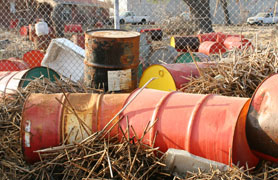
- Restrict the area to individuals actually involved in opening the container
- Consider the risk of explosion; provide shielding, open drums remotely, or provide other protection in the area where this may be a hazard
- Use material handling equipment and tools that prevent ignition (e.g., non-sparking, intrinsically safe) if a flammable atmosphere may be present in or around the drums and containers being moved/opened
- Open containers in a way that will allow internal pressure to be relieved safely; if this cannot be done remotely, then place a shield between the workers and the drums/containers to prevent injury
- Prevent workers from standing on drums
- Drums and containers containing packaged laboratory wastes must be considered shock-sensitive or explosive until characterized
Additional Personal Protective Equipment
Key Engineering Controls and Work Practices
- If crystalline material is observed on any container, handle the container as if it is shock-sensitive until the contents are identified
- Handle shock sensitive wastes using the following minimum additional special precautions
- Evacuate all non-essential workers from the transfer area
- Use material handling equipment with explosive containment devices or protective shields to protect equipment operators from exploding containers
- Signal the beginning and end of explosive waste handling activities using an worker alarm system that can be perceived above surrounding light and noise conditions
- Maintain continuous communications (using equipment that will not cause shock sensitive materials to explode) between the worker-in-charge of the immediate handling area, the site safety and health supervisor, and the command post throughout explosive waste handling activities
- Do not move drums and containers under pressure (bulging or swelling drums) until the cause of the excess pressure is determined and appropriate containment procedures have been implemented to protect workers
Key Engineering Controls and Work Practices
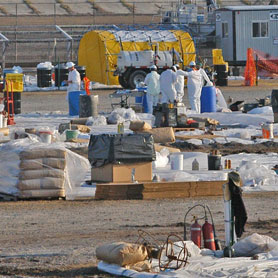
- Segregate containers of hazardous materials by expected hazard class
- Store incompatible hazard classes separately (e.g., oxidizers away from flammables)
- Store/stack containers securely so that they will not break or fall and so that they are clear of vehicular traffic and heavy equipment
- Provide spill containment, where necessary. Line hazardous material holding area with plastic sheeting and build a berm around the perimeter to contain leaking or spilled material
- At the end of each shift, cover hazardous materials that were not processed with plastic and close the lids on any drums
- Store and handle hazardous materials in areas with natural or forced ventilation; do not store or handle in low-lying areas
- If intact hazardous chemical containers are found with debris, segregate them from the waste stream before continuing work in the area
- If broken or leaking hazardous chemical containers are found with debris, contact a supervisor/hazardous material personnel for evaluation/removal before continuing work in the area
- If material that may contain asbestos is found with debris, contact a supervisor/hazardous material personnel for evaluation/removal before continuing work in the area. Thermal system insulation (formed or spray-on) is the asbestos-containing materials (ACM) of greatest concern for response and recovery worker exposure. Other materials that may contain asbestos include: vinyl floor tile, home siding and shingles, transite (including cement piping), flame retardant materials (e.g., gloves, curtains), and roof flashing
Additional Personal Protective Equipment
Key Engineering Controls and Work Practices
- Take frequent rest/water breaks
- Wear light-colored clothing
- If response and recovery workers wear protective suits that do not "breathe" (which can increase the risk of heat stress), use the buddy system or observe them to identify heat-related symptoms
- Also see general recommendations document
Key Engineering Controls and Work Practices
- Confined spaces have limited means of entry or exit, are large enough to bodily enter, and may contain physical (e.g., mechanical, electrical, hydraulic, pneumatic energy; engulfment hazards; inwardly converging surfaces) or atmospheric hazards (e.g., atmospheres that are oxygen-deficient or oxygen-enriched, contain or may contain flammable gas, vapor or mist, airborne combustible dust, toxic substances, or any other atmosphere that is immediately dangerous to life or health). Examples include storage tanks, process vessels, bins, boilers, vaults, ventilation or exhaust ducts, sewers, tunnels, pipelines, and pits more than 4 feet in depth
- Hurricane-related events might introduce hazards or potential hazards into confined spaces. For example, a space might have a potential to contain a hazardous atmosphere due to the presence of decomposing organic matter, to the use of hazardous chemicals in the space, or to the performance of operations in the space, such as welding, cutting, or burning, that may create a hazardous atmosphere. Additional precautions must be taken to make the space safe for entry
- Evaluate the need for entry (i.e., placing any body part into the space)
- If entry is required, see Entry into Confined Spaces activity sheet
Key Engineering Controls and Work Practices
- See Heavy Equipment and Powered Industrial Truck Use activity sheet
- See Crane Use activity sheet
Additional Personal Protective Equipment
- Hearing protection—see Noise hazard
Key Engineering Controls and Work Practices
- See Work Zone Safety and Traffic Control within a Work Area activity sheet
Additional Personal Protective Equipment
- ANSI/ISEA 107-2004 compliant high visibility safety apparel and headwear
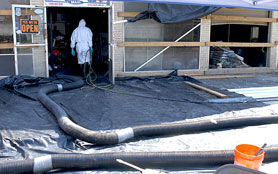
Key Engineering Controls and Work Practices
- Limit access/set up controlled access zones until stability and structural integrity is known
- Ensure that a competent person inspects building and floors before entry to perform work. A competent person is able to recognize existing and predictable hazardous conditions and has the authority to take prompt corrective measures to eliminate the hazardous conditions
- Install temporary structural support (shoring, bracing) adequate to protect response and recovery workers
Key Engineering Controls and Work Practices
- Assume that electrical lines are energized until proven otherwise. Lines and other conductors may become reenergized without warning as utilities are evaluated and restored after a disaster
- Inspect the work area for downed conductors and do not go near, drive over, or otherwise come in contact with them
- Downed electrical conductors can energize other objects, including fences, water pipes, bushes, trees, and telephone/CATV/fiber optic cables
- Unless deenergized and visibly grounded, maintain proper distance from overhead electrical power lines (at least 10 feet) and/or provide insulating barriers
- Do not approach any gas leaks; if a gas leak is detected, secure spark-producing devices (e.g., engines, tools, electronic, and communications equipment) and evacuate the area until the leak is secured
- Contact utility company to assist in locating, marking, and shutting off/purging utility lines that may pose a hazard or may be impacted; ensure that lines have been purged as needed before beginning work
Key Engineering Controls and Work Practices
- Remove or secure objects (glass, structural members) that may fall while workers work under them
- Use debris netting, sidewalk sheds, canopies, or catch platforms to reduce hazards from falling objects
- Verify the location of all other utility lines; ensure lines have been shut-off, capped, or otherwise controlled outside the building before beginning work. Notify utility companies before controlling their utility lines
- Assess the presence, contents, and condition of tanks and equipment that might contain hazardous chemicals, gases, or flammable materials. If the condition of tanks or equipment is suspect, avoid disturbing them until after the assessment is done and a plan of action determined
- Purge lines, tanks, and equipment containing hazardous chemicals, gases, or flammable materials. Use air monitoring equipment such as a combustible gas indicator, toxic gas monitor, or oxygen monitor to determine if any hazardous conditions remain. When necessary, provide additional controls to protect response and recovery workers (e.g., forced ventilation, respiratory protection)
- Provide and use safe walkways to reach any point without having to walk on exposed beams; walkways should be at least 18 inches wide and formed by using 2-inch thick wood, with stringers installed as needed for support
Key Engineering Controls and Work Practices
- Never attach a generator directly to the electrical system of a structure unless a qualified electrician has installed a transfer switch for the generator. If the structure's electrical system is not isolated, it may energize the utility's wiring system for great distances and create a risk of electrocution for utility workers and others in the area
- Always plug electrical equipment directly into the generator using the manufacturer's supplied cords or grounded (3-pronged) extension cords that are rated for the total anticipated load
- Do not overload a generator; it can overheat and create a fire hazard
- Ground and bond generators according to the manufacturer's recommendations; ensure that any manufacturer-required connections are secure before using the generator
- Keep the generator dry; protect with a canopy if needed; do not use it in wet or rainy conditions
- Carbon monoxide (CO) is a poisonous, colorless, and odorless gas that is produced by the incomplete burning of the generator's fuel. CO is harmful when breathed because it displaces oxygen in the blood and deprives the heart, brain, and other vital organs of oxygen
- Never use a generator indoors or in enclosed spaces such as garages and basements; opening windows and doors may not prevent CO from building up in those spaces. Do not use a generator outdoors near doors, windows, and vents that could allow CO to enter
- Ensure that a generator has 3 to 4 feet of clear space on all sides and above it to ensure adequate ventilation and cooling
- Before refueling, shut down the generator and allow it to cool
Additional Personal Protective Equipment
- Hearing protection—see Noise hazard
Key Engineering Controls and Work Practices
- Place generators, compressors, and other noisy equipment at a distance or behind a barrier when possible
Additional Personal Protective Equipment
- Hearing protection when working around potential noise sources and when noise levels exceed 90 dBA. A useful "rule of thumb"-if you cannot hold a conversation in a normal speaking voice with a person who is standing at arms length (approximately 3 feet), the noise level may exceed 90 dBA
Select any of the following potential hazards that can be associated with this activity in order to access relevant recommendations in the general recommendations document:
Additional Medical Needs
- Follow medical guidance and precautions outlined in the general recommendations document
- There are special medical requirements for members of designated/organized HAZMAT teams, hazardous materials specialists involved in emergency and post-emergency response activities, hazardous waste cleanup workers, and TSD facility workers. For all of these workers, employers must provide a medical surveillance program with initial, annual, and end-of-employment exams conducted in accordance with OSHA's HAZWOPER standard (29 CFR 1910.120(f) & 29 CFR 1926.65(f)) for any worker:
- Who may be exposed to hazardous substances at levels above permissible limits for 30 or more days per year
- Who may wear a respirator for 30 or more days per year
- In addition, medical surveillance/consultation must be offered to any worker who is injured, becomes ill or develops signs/symptoms of exposure to hazardous substances as a result of emergency response or hazardous waste operations
Additional Training Needs
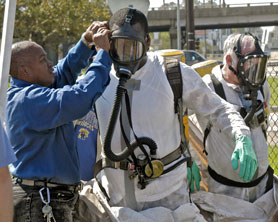
This picture shows actual disaster site work conditions and may not illustrate proper safety and health procedures.
- Follow general site- and task-specific training guidelines as outlined in the general recommendations document
- Most response and recovery workers performing emergency response to hazardous substance releases (e.g., controlling the release) require training consistent with OSHA HAZWOPER Hazardous Materials Technician or Hazardous Materials Specialist levels. For both groups, this involves 24 hours of specialized initial training and demonstrated competencies before the individual participates in the response; refresher training must be completed annually. Certain categories of response and recovery workers such as skilled support workers (e.g., heavy equipment operators) may require less training. For a complete list of training requirements for emergency response workers in responding to hazardous substance releases, see 29 CFR 1910.120(q)(6) & 29 CFR 1926.65(q)(6).
- Most response and recovery workers who perform hazardous substance cleanup operations, including post-emergency response operations at designated hazardous waste, cleanup, or TSD sites, require either 24 or 40 hours of specialized instruction (off the site) and actual field experience under the direct supervision of a trained and experienced supervisor. Employers must also provide these workers with 8 hours of refresher training annually. A reduced training requirement may apply under certain conditions (such as for limited work tasks or well-characterized sites). For a complete list of training requirements for hazardous substance removal or related activities, see 29 CFR 1910.120(e)(3) & 29 CFR 1926.65(e)(3) and 29 CFR 1910.120(p)(7) & 29 CFR 1926.65 (p)(7).
Related Activity Sheets
- Permit Required Confined Space
- Heavy Equipment and Powered Industrial Truck Use
- Work Zone Safety and Traffic Control within a Work Area
- Crane Use
Other Resources and References
- 29 CFR 1910.120, Hazardous waste operations and emergency response. OSHA Standard.
- 29 CFR 1910.134, Respiratory Protection. OSHA Standard.
- Respiratory Protection. OSHA Safety and Health Topics Page.
- NIOSH Respirator Selection Logic 2004. Centers for Disease Control and Prevention (CDC).
- 29 CFR 1910.132, Personal Protective Equipment. OSHA Standard.
- 29 CFR 1910 Subpart Z, Toxic and hazardous substances. OSHA.
- Hazardous Waste. OSHA Safety and Health Topics Page.
- Frequently Asked Questions: HAZWOPER. OSHA, (2005).
- The Application of HAZWOPER to Worksite Response and Cleanup Activities. OSHA.

